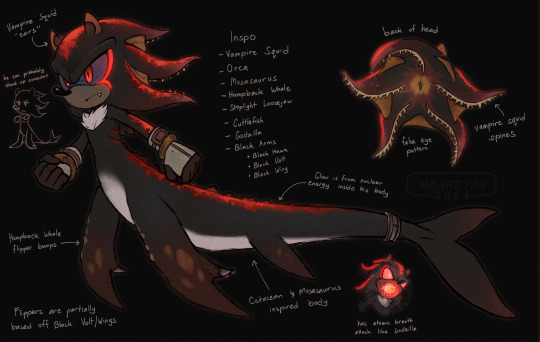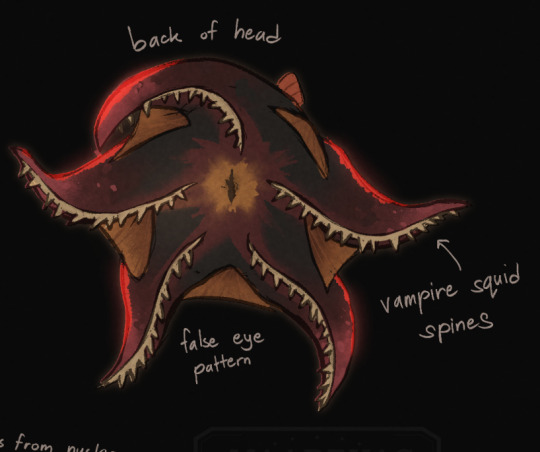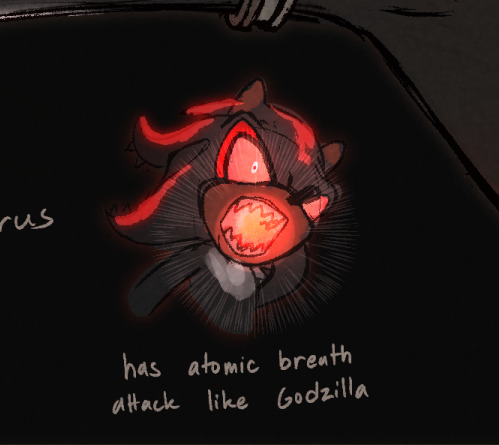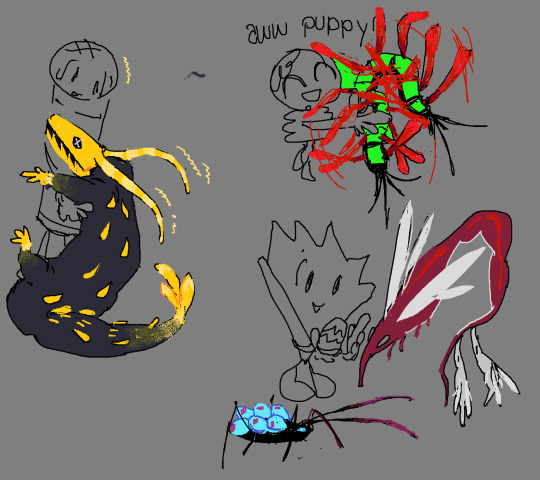#Research Facility
Explore tagged Tumblr posts
Text

I feel sick, but everyone is clapping. And so must I.



“We can’t just leave him there!”


“The mechanisms are on the inside. If I can get close enough- I only need one minute. One minute of distraction…”

[REDACTED] won’t be fast enough. I checked.

Please don’t tell him. Please.

This will be my last entry. Take care.

Researcher: [REDACTED]
Status: deceased
#via pinterest#log entry#excerpts from entries yet to come and entries that were lost to the sea#our grave below the sea#the mysterious researcher#[redacted]#mer au#mermaid au#aesthetic#fake research#research facility#mer Jason Todd#batfamily
119 notes
·
View notes
Text

#digitalart#future#advanced technology#research facility#exploration#deep sea#underwater#art#aiart#ai
3 notes
·
View notes
Text
Interesting...
I fear those 43 research center monkeys will never be captured and will cause an invasive primate problem in South Carolina.
32K notes
·
View notes
Text
Soujanya case | High standard of imparting education
High standard of imparting education is also complemented by some of the best facilities for students to practice what they are taught. These include 300 dental chairs, 60 phantom head tables, conventional and digital X-Ray equipment and research facility.
#imparting education#High standard#veerendra heggade#shri kshetra dharmasthala#nischal jain#nischal dharmasthala#digital X-Ray equipment#research facility
0 notes
Text

Young female athlete getting out of a water tank wearing a futuristic wetsuit.
#research facility#water#female athletes#female swimmer#modern architecture#modern building#swimming pool#white suit#white swimwear#white swimsuit#skintight#long hair#woman#ai photo#ai photography
1 note
·
View note
Text






#Chengdu Research Base of Giant Panda Breeding#Sichuan#China#World Wildlife Fund#giant pandas#pandas#conservation#tourism#research facility#lifetime ban#tourists
0 notes
Text

#digitalart#research facility#deep-sea creatures#art#scientists#advanced technology#underwater#future#ai#aiart
0 notes
Text
Over the last few years, I’ve begun to heavily encourage people to think of a zoo or aquarium or sanctuary being accredited as conveying important information about their ethos / operations / politics - but not as an inherent indicator of quality. Why? Because accrediting groups can be and are fallible. There are issues with all of the accrediting groups and programs, to varying degrees, and so they’re just a piece of information for a discerning zoo-goer to incorporate into their overall opinion. I just saw a news article go by with some data that proves my point.

First off, good for Houston, no commentary that follows is directed that them.
This isn’t the first time I’ve seen a headline like this - there was one a couple years ago, about Cheyenne Mountain Zoo in Colorado also getting a perfect inspection. But here’s what bugs me about it.
If you see/hear the phrase “Facility X has been accredited by Y organization, which holds the highest standards in the world for this type of facility”, it kind of implies that facility X meets all of those standards, doesn’t it? Not most of them, not the majority. When you hear that a zoological facility has gone through a rigorous process to earn an accreditation branded (by the accrediting org) as “the gold standard” in the industry… the general public is going to interpret that as saying these facilities are in compliance with every single rule or standard. And what these headlines tell us, alongside the commentary from AZA in the articles, is that it’s not only not true - it never has been true. Most AZA accredited facilities apparently don’t meet all the AZA standards when they’re inspected, and that’s both okay with them and normal enough to talk about without worrying about the optics.
Let’s start with the basic information in the Houston Chronicle article, which will have been provided to them by the zoo and the AZA.
“Since it's inception in 1974, the AZA has conducted more than 2,700 inspections and awarded only eight perfect evaluations throughout the process's 50-year history. Houston Zoo's final report is 26 pages long — and filled with A's and A-pluses."
Okay, so… doing that math, less than one percent of AZA accreditation inspections don’t meet all the standards at the time of inspection. But, wait, that’s not just what that says. That bit of information isn’t talk about AZA accredited facilities vs the ones that got denied accreditation: this is telling us that of facilities that earned AZA accreditation, basically none of them meet all the standards at the time. This isn’t talking about tabled accreditations or provisional ones where they come back and check that something improved. Given that math from earlier, this information means that most - if not all - AZA accredited facilities have repeatedly failed to meet all of the standards at one point in time … and have still been accredited anyway.
That tracks with what was said about Cheyenne Mountain Zoo, back in 2021 when they got their perfect accreditation.
“Cheyenne Mountain Zoo has earned an incredibly rare clean report of inspection and its seventh consecutive five-year accreditation from the Association of Zoos and Aquariums (AZA). In nearly 50 years of accreditations, CMZoo is only the fourth organization to earn a ‘clean’ report, which means there wasn’t a single major or minor concern reported”
Seven consecutive accreditation processes - and only one of them where they actually met all the standard at the time.
Here’s what the AZA CEO had to say about Houston’s accreditation achievement in that article, which reinforces my conclusion here:
"AZA president and CEO Dan Ashe says the multi-day inspection process, which occurs every five years, has been described as "comprehensive, exhausting and intimidating."
"We send a team of experts in who spend several days talking to employees, guests and the governing board. They look at animal care and husbandry. They look at the governance structure and finances. They look comprehensively at the organization," Ashe explains. "For a facility like Houston Zoo to have a completely clean accreditation and inspection is extremely rare. These inspectors are experts, it's hard to get to the point where they can't find something.""
Now, here’s the rub. We, as members of the public, will never have any idea which standards it is deemed okay for a given AZA facility to not meet. All of the zoological accrediting groups consider accreditation information proprietary - the only way we find out information about how a facility does during accreditation is if they choose to share it themselves.
On top of that, it’s complicated by the fact that last time I read them AZA had over 212 pages of accreditation standards and related guidance that facilities had to comply with. Now, AZA doesn’t accredit facilities if there are major deviations from their standards, or if there’s an issue on something important or highly contentious. So - based on my completely outsider but heavily researched perspective - this probably means that most zoos are in non-compliance with a couple of standards, but not more than a handful.
To make trying to figure this out even more fun, it is also important to know that AZA’s standards are performance standards: whether or not they’re “met” is based on a subjective assessment performed by the accreditation inspectors and the accreditation committee. This means that what qualifies as fulfilling the standards can and does vary between facilities, depending on who inspected them and the composition of the committee at the time.
So why do I care so much? Because when it comes to public trust, branding matters. AZA has gained a reputation as the most stringent accrediting group in the country - to the point that it can lobby legislators to write exceptions into state and federal laws just for its members - based on how they message about their accreditation program. How intensive it is, how much oversight it provides, what a high level of rigor the facilities are held to. That… doesn’t track with “well, actually, the vast majority of the zoos meet most of the standards most of the time.” People who support AZA - people who visit AZA accredited zoos specifically because of what it means about the quality of the facility - believe that accreditation means all the standards are being met!
To be clear: most AZA zoos do meet some pretty high standards. It’s likely that what are being let slide are pretty minor things. I expect it’s on stuff the facility can improve without too much hassle, and it might be that doing so is probably part of what’s required. There’s not enough information available to people outside the fold. But I will say, I don’t think any zoo is getting accredited despite AZA having knowledge of a serious problem.
Where I take issue with this whole situations is the ethics of the marketing and branding. AZA frames themselves as being the best-of-the-best, the gold standard, when it turns out that most of their accredited zoos aren’t totally in compliance, and they know and it’s fine. They seem to be approaching accreditation like a grade, where anything over a certain amount of compliance is acceptable. The public, though, is being fed a narrative that implies it’s a 99/100 pass/fail type of situation. That’s not super honest, imho, which shows up in how there’s zero transparency with the public about it - it goes unspoken and unacknowledged, except when it’s used for promotional gain.
And then, like, on top of the honesty in marketing part, it’s just… something that gets joked about, which really rubs me the wrong way. Like this statement from the media releases for the Cheyenne Mountain accreditation:
“Another of our ‘We Believe’ statements is, ‘We value laughter as good medicine,’” said Chastain. “To put this clean accreditation into perspective, when I asked Dan Ashe, AZA president and CEO, for his comments about how rare this is, he joked, ‘A completely clean inspection report is so unusual, and so unlikely, it brings one word to mind — bribery!’“
So, TL;DR, even AZA accreditation is designed so that their accredited zoos don’t have to - and mostly don’t - actually fully meet all the standards. I’d love to know more about what types of standards AZA is willing to let slide when they accredit a facility, but given the proprietary nature of that information, it’s pretty unlikely there will ever be more information available. AZA accreditation tells you what standards a zoo aspires to meet, what their approximate ethics are, and what political pool they play in. When it comes to the quality of a facility and their animal care, though, sporting an accreditation acronym is just a piece of the larger puzzle.
#AZA accreditation#zoo accreditation#zoo politics#my research#There’s a lot more nuance to how accreditation inspections work and how facilities with bigger issues are given changes to correct them#but that’s for another post#right now I’m just irked that it is so normative for AZA facilities to get accredited without clean inspections
487 notes
·
View notes
Text




Not as comprehensive design-wise as Silver was, but here's my take on a merhog Shadow ✨ Still some sort of half-alien experiment, but now his Chaos energy is just plain old nuclear radiation.
An aggressive merhog who haunts the remains of a deep sea research facility after an explosion wiped it out. He's the only one who can survive being in the exclusion zone, so it's been difficult for him to find new friends. (and food, but he's surviving off the radiation well enough)
#sonic#shadow the hedgehog#sth#mermay#sonic fanart#my art#i wanted to save this design sheet until AFTER I would be able to make a painting for him#but I only just now solidified his design and I'm not sure what sort of scene to put him in yet#anyways Shadow doesn't look as cool as Silver but I think he benefits from the simplicity#he still has the ultimate lifeform thing going on#he can probably?? swim between different depths and not worry about the pressure changes#though he prefers to stay at the research facility (for now)
338 notes
·
View notes
Note
Ooo what do the clearance levels go up to and what do they indicate???
They go up to level 6!
They indicate which floors you’re allowed on and the server information you can access.
It’s also an indicator of how important your work is within the facility! Level 1 for example is usually reserved for sea faring expeditions (because they have the highest mortality rate and level 1 researchers are easiest to replace…).
In contrast, level three sorts through more sensitive data, is hands on with the subjects they keep in the facility, and have a hand in lab research.
All in all, the research facility is… very large. Large enough to keep a juvenile Leviathan contained (for a time).
30 notes
·
View notes
Text

Slowly becoming yourself again
#by the time epilogue rolls around 4's hair will be back to where it's been before#older doodle I ended up polishing too much#I'm unwell about him (and the EP kids in general)#I gotta finish some of those research facility doodles and make a compilation because man#WfM fan AU#the witch from mercury#elan ceres#el4n
70 notes
·
View notes
Text




This fella surely has some funny lines 😂
329 notes
·
View notes
Text
I love how ominous such basic names like "The Organization" or "The Institute" or "The Initiative" or "The Facility" or etc. are when placed in like a shady sci-fi context, like there's no reason for them to sound that suspicious, but without elaboration, it's like here is a place where they are doing things™ and I am like ooohh, because the blank state, the refusal to give you any more detail makes you think they're hiding something on purpose and leaves the darkest corner of the imagination left to fill in the rest.
#writing#writeblr#names#i want to give my shady research facilities in my stories actual names but some part of me is like#you'll never get the level of unease you get from just naming it the institute rather than the x institute or something#sci-fi#other genres i guess too but usually sci-fi#the barn in haven why is that the scariest sounding thing ever like?#you just know that thing ain't a barn#it is a barn physically outside but oh the creep factor that name gives i can't explain#the shop in firestarter? like f*ck it conjures up images of a workshop and saws building and tearing apart people for some reason#the initiative in buffy it's so nondescript and unassuming just like its soldiers living among the campus and the military power they hold#etc etc etc you know#mayhaps i am not creative enough to come up with better names also mayhaps
2K notes
·
View notes
Text

ii characters with the creatures i think they would be if they were in rain world (spoiler none of them are slugcats)
#inanimate insanity#ii#microphone ii#lightbulb ii#fan ii#rain world#this is super niche idk if there are other ii rainworlders but know my truth#all the mephones would be iterators btw#cobs some high ranking benefactor that oversaw the production of many projects#would be kewl if ii happened inside mephonr4 like he cleared out some space in his transform arrays and led creatures from the surface into#him as research for like social psychology and how the creatures he isnt capable of interacting with much interact with Each other#taking animals from across his facility grounds and seeing what happens#gives them the mark of communication after season 1 (first experiment)#if someone had to be a slug id say probably.Taco. sighs#i said scav originally but slugs are shown to be better at living solitarily whereas scavs are very social#test tube is an elite scav taco steals from she has -100 rep#Ok im done
73 notes
·
View notes
Text
Another One 👆
Rock City is a tourist attraction on Lookout Mountain in Lookout Mountain, Georgia. Opened in May 1932, the attraction gained prominence after owners Garnet and Frieda Carter hired Clark Byers in 1935. 1400 Patten Road, 30750, Lookout Mountain, Georgia...

5 million square feet available 🤔
#pay attention#educate yourselves#educate yourself#knowledge is power#reeducate yourself#reeducate yourselves#think about it#think for yourselves#think for yourself#do your homework#do some research#do your own research#ask yourself questions#question everything#tunnels#underground facilities
227 notes
·
View notes
Text
My Research: Why did you take these photos? These aren't relevant.
Me: They are. In my heart. Vaguely relevant.
My Research: What's with this random tree?


Me: It's a nanakamado.
My Research: And this photo of a photo of some little sprout?

Me: That's taranome.
My Research: It'd be one thing if it was just plants, but why did you take this photo of Togakure ninja training methods? This, among all those other photos?
Me: ...
My Research: "Headbutt Training"?!

#if Tanjiro was a Hashira and provided Hashira training#there was also a bloody photo of helping each other with this against a boulder#i did not interview any ninja#and a lot of this facility was to display old daily objects and crafts#like straw snowboots and bamboo baskets big enough to fit your demon sister inside of#though there are lots of other museums of old daily items and of ninja stuff#if you ever come to Japan please please please venture away from the big cities#there are so many good things to enjoy in the countryside#my exasperated unrelated research#my unrelated exasperated research
133 notes
·
View notes